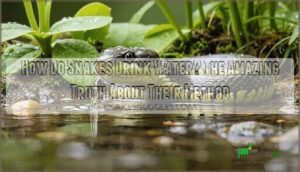This site is supported by our readers. We may earn a commission, at no cost to you, if you purchase through links.

They’ve got a built-in straw system that works through suction power.
When a snake needs hydration, it positions its mouth at the water’s edge and opens its glottis—a special breathing tube on its mouth floor.
The snake then pumps its throat muscles rapidly, creating a vacuum that sucks water straight into its stomach.
Think of it like using a straw, but the entire throat becomes the pumping mechanism.
This clever adaptation lets them drink from puddles, streams, or even dewdrops.
Their unique anatomy holds more surprising secrets.
Table Of Contents
- Key Takeaways
- How Do Snakes Drink Water?
- Snakes’ Unique Drinking Method
- Structure of a Snake’s Mouth
- Drinking Process Without Lips or Paws
- Utilization of Kinetic Energy for Ingestion
- Adaptations for Hydration in Diverse Habitats
- Frequently Asked Questions (FAQs)
- Do snakes drink water through their skin?
- How to tell if a snake is drinking water?
- Do snakes get thirsty?
- How long can a snake go without water?
- How often do snakes need to drink water?
- Can snakes drink saltwater or only freshwater?
- Do baby snakes drink differently than adult snakes?
- What role does a snakes venom play in hydration?
- How do snakes find water sources in the wild?
- Do snakes need water bowls in captivity?
- Conclusion
Key Takeaways
- You’ll be amazed to learn that snakes don’t use their tongues to drink water – instead, they’ve got a built-in straw system that works through powerful throat suction to pull water directly into their stomachs.
- Most snakes use a sponge mechanism where soft tissue folds in their lower jaw compress and expand like a kitchen sponge to absorb water, while some species like boa constrictors create an airtight seal and suck water in like you’d use a straw.
- You won’t see snakes drinking daily like other animals – they typically drink every few days to weekly depending on their environment, with desert species drinking less frequently than tropical ones.
- Snakes can’t drink saltwater and must find fresh water sources, even sea snakes have to wait for rainwater on the ocean’s surface to stay hydrated since their bodies can’t process salt like yours can.
How Do Snakes Drink Water?
Picture watching a snake at a water’s edge – you’ll witness one of nature’s most fascinating drinking methods.
Unlike mammals that lap water, snakes use two distinct techniques for snake hydration. Most species employ a sponge mechanism, where soft tissue folds in their lower jaw absorb water like a kitchen sponge.
Snakes transform drinking into biological artistry, using jaw sponges and throat suction where mammals simply lap.
Meanwhile, boa constrictors demonstrate straw drinking by sealing their mouths and creating suction to pull water through a tiny opening.
Snakes also benefit from environmental factors, such as humidity aiding hydration.
The tongues role isn’t what you’d expect – these forked organs collect scents, not water.
Instead, scale channels help retain moisture droplets for absorption.
Whether drinking from puddles, streams, or collected rainwater, snakes have adapted remarkable ways to access water sources across diverse habitats, making snake drinking water an engineering marvel.
Snakes’ Unique Drinking Method
Unlike other animals that lap water with their tongues, snakes use a completely different approach for hydration.
You’ll be amazed to learn that most snakes rely on a sponge mechanism to drink water.
This fascinating snake drinking technique involves soft tissue folds in their lower jaw that compress and expand like a sponge, absorbing water directly into their mouth.
However, some species like boa constrictors use what’s called the straw method.
They create an airtight seal with their mouths and generate negative pressure by expanding their throats, literally sucking water in like you’d use a straw.
Snakes in arid environments may also absorb moisture through skin to stay hydrated.
While you might see a snake flicking its tongue near water sources, remember that the tongue’s role isn’t for drinking—it’s for detecting chemical signals in the environment.
Their unique jaw anatomy makes these specialized snake drinking mechanisms possible, allowing efficient snake hydration across diverse habitats without traditional lips or limbs.
Structure of a Snake’s Mouth
A snake’s mouth structure is nature’s engineering marvel, perfectly designed for survival without lips or paws. The jaw flexibility comes from quadrate bones that allow complete jaw unhinging, while elastic ligaments permit extreme stretching during feeding.
Here’s what makes snake anatomy so fascinating:
- Quadrate bones enable jaw dislocation for massive prey
- Elastic ligaments stretch beyond normal limits
- Independent mandible movement on each side
- Backward-curved teeth prevent prey escape
The forked tongue function provides chemical sensing, while microscopic scale channels aid water collection. This remarkable mouth structure transforms drinking into an art form. Snakes also possess polyphyodont dentition, which allows for continuous tooth replacement.
Drinking Process Without Lips or Paws
Since snakes lack lips or paws, they’ve mastered a remarkable snake drinking process that relies on specialized jaw mechanics and muscle action. You might wonder how these creatures manage without conventional drinking tools.
Snakes transform jaw mechanics into drinking mastery, proving nature’s ingenuity thrives without conventional tools.
The snake drinking behavior centers on their unique snake mouth structure. When drinking, snakes keep their heads perfectly still and create soft tissue folds in their lower jaw that act like tiny sponges. These folds facilitate water absorption through a passive process rather than active scooping.
Snake drinking techniques involve depressing the lower jaw to generate negative pressure, drawing water into these sponge-like structures. Some species like boa constrictors use sucking methods, sealing their mouths and creating suction similar to drinking through a straw.
Interestingly, the tongue role in drinking is minimal. Despite their forked tongues being perfect for sensing their environment, they’re practically useless for water consumption. Instead, muscle action in the jaw and throat facilitates the entire drinking process through this ingenious biological adaptation. Snakes also rely on capillary action to draw water into their mouths.
Utilization of Kinetic Energy for Ingestion
While you might expect snakes to simply slurp water like other animals, they’ve mastered a sophisticated system that harnesses jaw kinetic energy to fuel their drinking water needs.
This remarkable snake drinking physiology transforms basic physics into survival.
The process involves five critical snake drinking techniques:
- Rapid jaw movements that create kinetic energy through quick opening and closing motions
- Tongue pumping action that generates suction by moving rapidly within the mouth
- Capillary action that draws water along the tongue’s surface through molecular attraction
- Gravity assistance that helps pull water down the throat once captured
- Muscular contractions that push water through the digestive system
When drinking methods require precision, snakes excel.
Their rapid jaw movements generate the initial force, while the tongue pumping action creates a mini-vacuum effect.
This coordinated effort controls water trajectory efficiently.
Snakes also use saliva as lubricant to aid in swallowing prey or, in this case, water.
The muscular contractions then complete the process, ensuring every drop reaches their stomach.
It’s drinking water mechanics at its finest.
Adaptations for Hydration in Diverse Habitats
Snakes have mastered snake drinking adaptations across every environment you can imagine. Desert species use specialized scales to collect dew and extract moisture from prey – their snake water survival strategies rival any survival expert’s techniques.
Marine snakes can’t drink saltwater, so they wait for rain on the ocean’s surface. A key factor is to maintain ideal humidity for healthy hydration.
Snake hydration methods vary dramatically based on their homes.
| Habitat | Water Sources | Adaptations |
|---|---|---|
| Desert | Dew, prey moisture | Water-collecting scales |
| Ocean | Rainwater only | Salt-filtering skin |
| Forest | Streams, humidity | Standard drinking method |
Frequently Asked Questions (FAQs)
Do snakes drink water through their skin?
Picture a desert rattlesnake after rainfall – you might wonder if it absorbs water like a sponge.
No, snakes don’t drink through their skin.
They use specialized jaw mechanisms to suck water directly into their mouths instead.
How to tell if a snake is drinking water?
Watch for your snake’s head to remain still while subtle movements occur in their throat and jaw area.
You’ll notice the sponge-like tissue in their lower jaw expanding and contracting rhythmically as they absorb water.
Do snakes get thirsty?
You’ll find that snakes experience thirst just like any other animal.
When they’re dehydrated, they actively seek water sources, showing clear signs like wrinkled skin and reduced activity until they drink.
How long can a snake go without water?
Most species can survive several weeks to months without drinking, depending on their environment and diet.
However, pelagic sea snakes hold the record, surviving up to seven months without fresh water access.
How often do snakes need to drink water?
Snakes don’t drink daily like you’d expect.
Most species drink every few days to weekly, depending on their environment, diet, and humidity levels.
Desert snakes drink less frequently than tropical species.
Can snakes drink saltwater or only freshwater?
Unlike land creatures who can sip from any source, you’ll find that snakes can’t drink saltwater.
They need fresh water only – even sea snakes must find rainwater puddles to survive and stay hydrated.
Do baby snakes drink differently than adult snakes?
Baby snakes drink using the same sponge-like mechanism as adults, but they’re smaller and drink less frequently.
You’ll notice their tiny jaw movements work identically—they just need proportionally less water for their size.
What role does a snakes venom play in hydration?
Like a perfectly sealed container keeping its contents separate, venom glands don’t interfere with your snake’s drinking process.
You’ll find that venom production operates independently from hydration systems, serving only for prey capture and defense mechanisms, and this independence is crucial for the snake’s overall health and survival, highlighting the importance of hydration systems.
How do snakes find water sources in the wild?
Wild snakes locate water through their keen sense of smell, detecting moisture in the air.
They’ll follow scent trails to puddles, streams, and dew-covered surfaces, using their forked tongues to guide them toward hydration sources.
Do snakes need water bowls in captivity?
Sure, your snake isn’t going to order takeout.
Yes, you absolutely need water bowls in captivity.
Place fresh, filtered water in cooler areas and clean regularly to keep your slithery friend hydrated and healthy.
Conclusion
Truly, understanding how snakes drink water reveals nature’s incredible engineering at work.
You’ve discovered that snakes don’t need lips or tongues to stay hydrated—their throat muscles create powerful suction that draws water directly into their bodies.
This remarkable adaptation allows them to thrive in countless environments, from desert oases to tropical rainforests.
Next time you see a snake near water, you’ll appreciate the sophisticated pumping system hidden beneath their simple appearance.
- https://reptilestartup.com/do-snakes-drink-water/
- https://www.researchgate.net/figure/A-sponge-model-of-water-transport-in-snakes-By-keeping-the-lower-end-of-the-sponge_fig11_221812092
- https://pubmed.ncbi.nlm.nih.gov/10862729/
- https://reptilesdoc.com/do-snakes-drink-water/
- https://www.lehigh.edu/~inbios/Faculty/Cundall/PDF/Cundall_etal_2012.pdf









